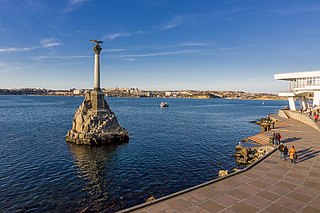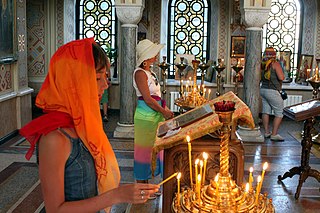
Sevastopol, sometimes written Sebastopol, is the largest city in Crimea and a major port on the Black Sea. Due to its strategic location and the navigability of the city's harbours, Sevastopol has been an important port and naval base throughout its history. Since the city's founding in 1783 it has been a major base for Russia's Black Sea Fleet. During the Cold War of the 20th century, it was a closed city. The total administrative area is 864 square kilometres (334 sq mi) and includes a significant amount of rural land. The urban population, largely concentrated around Sevastopol Bay, is 479,394, and the total population is 547,820.

The Arabat Spit or Arabat Arrow is a barrier spit that separates the large, shallow, salty Syvash lagoons from the Sea of Azov. The spit runs between the Henichesk Strait in the north and the north-eastern shores of Crimea in the south. It is the largest of several spits of the Sea of Azov.

The Ukrainian Navy is the maritime forces of Ukraine and one of the eight service branches of the Armed Forces of Ukraine.

The Crimean campaign was conducted by the Axis as part of Operation Barbarossa during World War II. The invading force was led by Germany with support from Romania and Italy, while the Soviet Union took up defensive positions throughout the Crimean Peninsula. The Axis offensive routed the Red Army and enabled the three-year-long German occupation of Crimea.

The Crimean offensive, known in German sources as the Battle of the Crimea, was a series of offensives by the Red Army directed at the German-held Crimea. The Red Army's 4th Ukrainian Front engaged the German 17th Army of Army Group South Ukraine, which consisted of Wehrmacht and Romanian formations. The battles ended with the evacuation of the Crimea by the Germans. German and Romanian forces suffered considerable losses during the evacuation.

Krasnoperekopsk or Yany Kapu is a city in Crimea. Following the 2014 annexation of Crimea, it was incorporated into Russia's Republic of Crimea. However, a majority of countries recognises the territory as part of Ukraine within the Autonomous Republic of Crimea. It is the administrative center of Krasnoperekopsk Raion. Administratively is not a part of the raion (district) and is incorporated separately as a town of regional significance. Population: 26,268 .

The recorded history of the Crimean Peninsula, historically known as Tauris, Taurica, and the Tauric Chersonese, begins around the 5th century BCE when several Greek colonies were established along its coast, the most important of which was Chersonesos near modern-day Sevastopol, with Scythians and Tauri in the hinterland to the north. The southern coast gradually consolidated into the Bosporan Kingdom which was annexed by Pontus and then became a client kingdom of Rome. The south coast remained Greek in culture for almost two thousand years including under Roman successor states, the Byzantine Empire (341–1204), the Empire of Trebizond (1204–1461), and the independent Principality of Theodoro. In the 13th century, some Crimean port cities were controlled by the Venetians and by the Genovese, but the interior was much less stable, enduring a long series of conquests and invasions. In the medieval period, it was partially conquered by Kievan Rus' whose prince Vladimir the Great was baptised at Chersonesus Cathedral, which marked the beginning of the Christianization of Kievan Rus'. During the Mongol invasion of Europe, the north and centre of Crimea fell to the Mongol Golden Horde, and in the 1440s the Crimean Khanate formed out of the collapse of the horde but quite rapidly itself became subject to the Ottoman Empire, which also conquered the coastal areas which had kept independent of the Khanate. A major source of prosperity in these times was frequent raids into Russia for slaves for the Crimean slave trade.
As of January 2021, the estimated total population of the Republic of Crimea and Sevastopol was at 2,416,856. This is up from the 2001 Ukrainian Census figure, which was 2,376,000, and the local census conducted by Russia in December 2014, which found 2,248,400 people. According to the Ukrainian census, Perekop and Pervomaisky districts had a Ukrainian ethnic majority, while the rest of Crimea had a simple or absolute majority of ethnic Russians.

The Crimean People's Republic or Crimean Democratic Republic was a self-declared state that existed from December 1917 to January 1918 in the Crimean Peninsula. The Republic was one of many short-lived states that declared independence following the 1917 Russian Revolution caused the collapse of the Russian Empire.

The Crimean Regional Government refers to two successive short-lived regimes in the Crimean Peninsula during 1918 and 1919.

The Russia–Ukraine border is the de jure international boundary between Russia and Ukraine. Over land, the border spans five Russian oblasts and five Ukrainian oblasts. Due to the ongoing Russo-Ukrainian War, which began in early 2014, the de facto border between Russia and Ukraine is different from the legal border recognized by the United Nations. As of 2024, Russia is militarily occupying a significant portion of Ukraine. Whereas, Ukraine is militarily occupying a very small portion of Russia.

Sevastopol Marine Trade Port (SMTP) is a port in Sevastopol. It is located mainly at the Bay of Sevastopol, and at smaller bays around the Heracles peninsula. The port infrastructure is fully integrated with the city of Sevastopol and naval bases of the Russian Navy and the Black Sea Fleet.

The Autonomous Republic of Crimea is a de jure administrative division of Ukraine encompassing most of Crimea that was unilaterally annexed by Russia in 2014. The Autonomous Republic of Crimea occupies most of the peninsula, while the City of Sevastopol occupies the rest.

Yuliy Valeriyovych Mamchur is a colonel in the Ukrainian Air Force who, for three weeks in March 2014, refused to abandon his post in Belbek, Crimea amidst the annexation of Crimea by the Russian Federation while surrounded and outnumbered by Russian forces. Mamchur is also credited for restraining amiably and diplomatically both his soldiers and pro-Russian forces from escalating tensions further, asking both sides not to shoot each other while the situation defuses.

In February and March 2014, Russia invaded the Crimean Peninsula, part of Ukraine, and then annexed it. This took place in the relative power vacuum immediately following the Revolution of Dignity. It marked the beginning of the Russo-Ukrainian War.

On 18 March 2014, Russian president Vladimir Putin gave a speech to both chambers of the Federal Assembly of the Russian Federation in connection with the request for admission by the Crimean parliament of the republic in the Russian Federation. He spoke in the St. George Hall of the Grand Kremlin Palace in the Moscow Kremlin.

The majority of the Crimean population adheres to the Russian Orthodox Church, with the Crimean Tatars forming a Sunni Muslim minority, besides smaller Roman Catholic, Ukrainian Greek Catholic, Armenian Apostolic and Jewish minorities.

The Governor of Sevastopol is head of the executive branch of the political system in the city of Sevastopol. The governor's office administers all city services, public property, police and fire protection, most public agencies, and enforces all city and state laws within Sevastopol.

The Evacuation of the Crimea was an event in the Russian Civil War, in which the Government of South Russia evacuated over sea from the Crimean Peninsula, the last stronghold of the White movement on the Southern Front, bringing an end to the fighting on that Front.


















